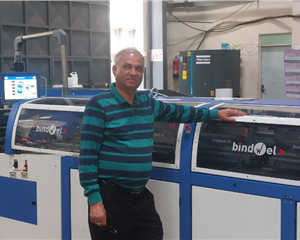Approaches to incremental change in using plastic - Arjun Dewan
Instead of jumping the gun following the ban on plastic, Arjun Dewan suggests a step-by-step approach to incremental change in reducing the use of plastic
09 Jul 2018 | By Dibyajyoti Sarma
India was the host nation for World Environment Day celebrations this year; the theme of the year being ‘Beat plastic pollution’. The abuse of plastic by all of us has led to a situation where plastic is being blamed for degrading our environment, almost as if plastic gets up and decides to clog our rivers, choke our drains, or get eaten by animals on its own free will!
The issue finally came to a head with the government of Maharashtra deciding to enforce a complete ban on plastic by issuing a notification in March this year.
The government notification bans manufacture, use, transport, distribution, wholesale and retail sale, storage and import of plastic bags with and without a handle. The ban also covers disposable products, made from plastic and thermocol (polystyrene), such as single-use disposable dishes, cups, plates, glasses, fork, bowl, container, disposable dish/bowl used for packaging food in hotels, spoon, straw, non-woven polypropylene bags, cups/pouches to store liquid, packaging with plastic to wrap or store the products and packaging of food items and grain material.
The ban is not applicable to PET bottles, irrespective of capacity. These bottles, however, should have predefined buyback price, depending on the size printed on them.
Plastic used for packaging of medicines, compostable plastic bags or material used for plant nurseries, handling of solid waste, plastic bags not less than 50 micron thickness used for packaging of milk (with the specific purpose printed on it), plastic manufactured for export in SEZs and plastic to wrap the material at the manufacturing stage are excluded from the ban. The ban is applicable to manufacturers and consumers as well as the chain in between, which includes shops, hawkers, vendors and offices.
What it means
At one level, the decision of the government is a step towards the right direction. The environment is a real concern. Yet, the decision has sent all stakeholders to the edge. This is not just because the use of plastic has already permeated all aspects of our lives, it is also cheap, and we have built an entire ecosystem on the use of plastic, from milk packets to carry bags and everything in between.
Under these circumstances, it’s easy to side with the plastic lobby and criticise the ban (It will not last for more than a few months. Already, an exception has been made for kirana stores.) and question its viability (What’s the alternative? How much more will it cost us?)
Alternatively, we can look at how our industry can adopt smart practices that either replace products from the plastic family or ensure that their use is environmentally smart.
Plastic and how it’s used
Products from the plastic family are commonly used for the following three reasons by printers and paper traders —packing; protection and aesthetics and convenience.
When it comes to packaging, it has become the norm to use a clear transparent plastic bag to pack virtually everything. In North India, we call it ‘panni’ and you will find it used to pack everything from paper to finished product printed using it. Bubble wraps, polythene bags, tapes are all examples of plastic being used for packaging.
As protection, plastic is used as a barrier protector for keeping moisture, odour or dirty hands away from the product. Another example of protection is lamination. In fact, all examples under the packing section are also examples where protection is implicit.
Ease of storage, long shelf life, ability to accept colour, print and shape make plastic an attractive option for aesthetics and convenience. From file folders to branded wrapping sheets, the examples of plastic being used for aesthetic and convenience are many.
Reducing the use of plastic
The key here is reduction, but not complete avoidance. If we want to move away from plastic, we can trust the power of definitive incremental change by which we can reduce, replace or recycle products from the plastic family. Definitive incremental change is achievable in place of sweeping change, because, sweeping changes, like New Year resolutions, are sexy to announce and impossible to adhere to.
The first step is to question why.
By questioning why we use plastic, we can reduce our quantity of plastic. It may happen at a simple operator level when we question why we need to tape a product twice, or at a policy level deliberation on the need to use plastic to wrap a product and then use a carton followed by a barrier protection film.
Questioning why we are using plastic will definitely make us more aware about the quantum of use and its necessity. Quality management tools like 5Why will be useful to give this exercise a structured approach. Kaizen at the shop floor will also help empower and bring about improvement. If all of us question why we are using plastic, its use is bound to come down. Where plastic is essential, we can consider increasing the efficiency of its use.
Replacing plastic
When we laminate a sheet, we essentially protect it. An inline aqueous coating is an alternative that offers protection and can be used to replace laminates in select cases. Aqueous coating is subtle and with an appeal.
According to a UK-based printer, Geoff Neal Litho, ‘Aqueous-coated products are recyclable with low or no environmental impact.’ Plus, additions like bio seal mean that frequently used products like in-flight magazines can be made germ-free through specialised additives.
However, replacement is not possible in all cases. Getting the right barrier properties, light-weighting, heat-proofing, the sort of things that plastic is good for, is not something that is done by aqueous coating. So replace only where feasible.
Companies are making specialised products with an aim to replace plastic. Stora Enso launched Dura Sense, a product made from wood-based bio-degradable material that replaces plastic in products like pallets, boxes and caps. Dura Sense reduces plastic use by up to 60% according to the company.
Similarly, Metsä Board launched an eco-barrier paperboard that uses a coating which is bio-based, recyclable and biodegradable. Designed for the foodservice industry, the paperboard offers grease resistance up to KIT level 5.
Food Board, from MM Karton, is a plastics-alternative that addresses food safety and shelf-life concerns. The coated carton board offers the high levels of contamination protection for dried and fast food, similar to plastic. Plus it is recyclable and biodegradable.
For the replacement to be effective practically, we need to work on the entire eco-system. Biodegradable alternatives need to be treated in specialised units. Education is critical. If a recycling unit confuses a biodegradable film for plastic, it will not process the product for recycling, thereby defeating the entire objective.
Recycling
Recycling and re-using plastic is another way by which damage can be avoided. Labelling is an important step here. Most sellers do not explicitly label the base plastic and therefore you could end up products that are PVC, polyester or BOPP-based. Mixed origin polymers are impossible to recycle. By labelling them at the source and on the product, they can be effectively segregated. This makes recycling possible. Because something can be recycled does not mean it will be. For that to happen, an effective system of waste collection and processing is required. Labelling is a first step towards ensuring awareness towards this objective.
Since printers are often concentrated around particular areas, the printer association can take the lead in recycling by creating awareness and also a mechanism of waste collection. Printer waste has economic value and properly segregated waste is critical for recycling.
To reiterate, incremental changes and definitive action can have far-reaching impact. The suggestions for reducing, replacing or recycling plastic can be a start. Printers with a wealth of knowledge and experience will have other options to offer. A platform to share such experience and extending discussion on this subject will be a welcome initiative.
Collectively, we can find a solution to all problems – including fighting the harmful effects of plastic and plastic-based products.
(Arjun Dewan is a partner at NandiniAakarshita, a Gurgaon-based start-up offering products and services centred around the paper.)














 See All
See All